You’ve probably thrown away more treasure than you realize. That broken smartphone contains real gold, and those discarded X-ray films hold recoverable silver worth actual money. While most people see trash, innovative jewelry makers are transforming electronic waste, ocean debris, and medical byproducts into stunning accessories that rival traditional pieces. You’re about to discover how everyday discards become profitable, sustainable jewelry—and why major brands can’t ignore this growing movement.
E-Waste Mining: Extracting Gold and Silver From Electronics
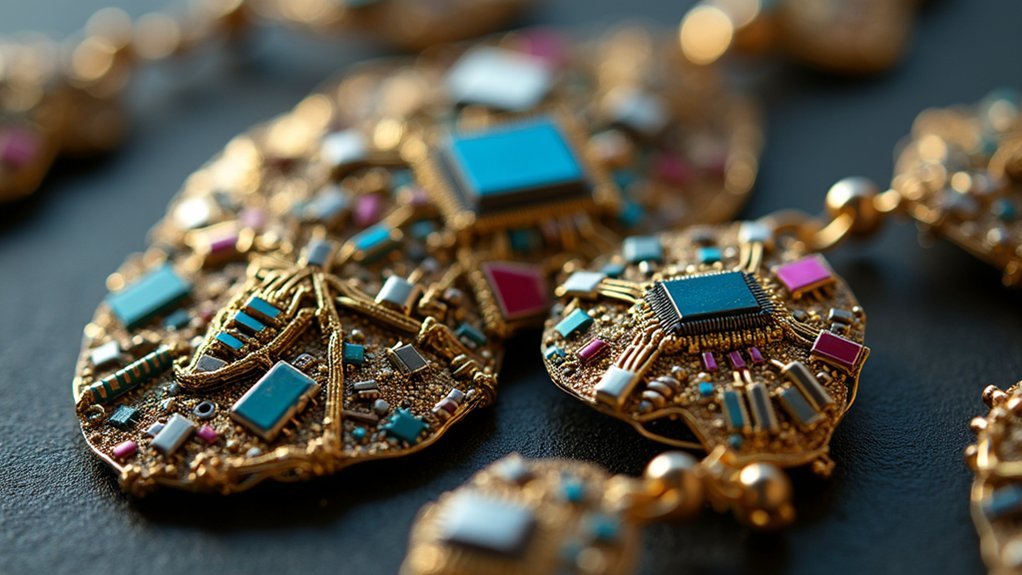
While you might expect gold to come from deep underground mines, your old smartphone contains more precious metal per gram than traditional ore deposits.
E-waste mining reveals that one ton of discarded electronics yields approximately 300 grams of gold—ten times more than what you’d extract from traditional earth ore. You’ll find silver and other precious metals hiding in your circuit boards, processors, and connectors.
This process transforms what you’d normally throw away into valuable resources. Companies like Emblème have already capitalized on this opportunity, sourcing gold from electronic components within an hour from Paris.
When you consider that global e-waste production reached 64.5 tons in 2017, you’re looking at an untapped goldmine sitting in landfills worldwide, waiting for innovative extraction methods.
Beach Cleanup Materials: Turning Ocean Debris Into Wearable Art
Beyond electronic components, ocean debris offers another surprising source for sustainable jewelry creation. You can transform beach trash into treasure through innovative upcycling techniques that support environmental awareness while creating stunning wearable art.
Local jewelry designer Hannah Millner demonstrates this concept by partnering with Surfrider Humboldt’s beach cleanup volunteers to collect materials. During these events, you’ll find diverse debris suitable for crafting:
- Plastic cups and containers for colorful statement pieces
- Glass shards that can be polished into beautiful pendants
- Tin cans transformed into unique metallic elements
Millner’s special edition “beach trash” jewelry line donates proceeds to ocean cleanup organizations.
When you wear these pieces, they serve as daily reminders of plastic waste’s longevity, encouraging reflection on your environmental impact while promoting collective action for marine preservation.
Medical Waste Recovery: Repurposing X-Ray Film Silver
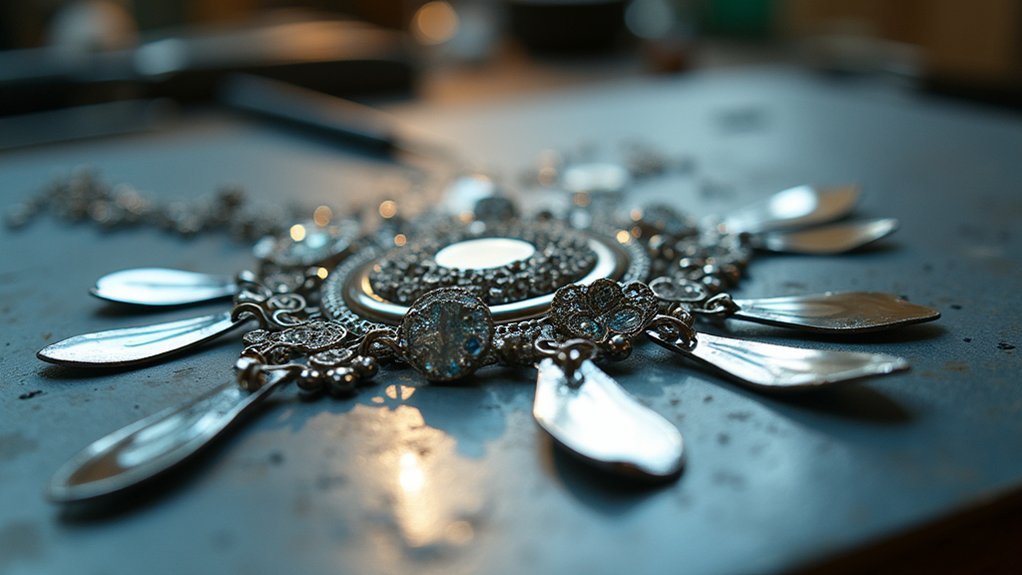
You might be surprised to learn that discarded medical X-ray films contain approximately 0.3 grams of valuable silver per film, making them a goldmine for sustainable jewelry creation.
Companies like Betts Metals have mastered the silver extraction process from medical waste, recovering precious metals that would otherwise end up in landfills.
When you choose jewelry made from repurposed X-ray film silver, you’re supporting a practice that eliminates mining’s environmental damage while addressing the global e-waste crisis where only 16% gets recycled.
Silver Extraction Process
Although X-ray films pile up in medical facilities worldwide as apparent waste, they’re actually treasure troves containing recoverable silver.
You’ll find that specialized companies use sophisticated extraction processes to transform this medical waste into valuable precious metals for jewelry production.
The silver recovery process involves several key steps:
- Chemical stripping – Technicians use specialized solutions to dissolve silver particles from film emulsion layers.
- Purification filtering – Advanced equipment separates silver from other materials and contaminants.
- Refinement processing – Recovered silver gets refined to meet jewelry industry purity standards.
You’re supporting sustainable practices when you choose jewelry made from reclaimed medical waste silver.
This eco-friendly approach reduces environmental impact while providing high-quality materials that jewelers can craft into stunning pieces.
Environmental Impact Benefits
Recovering silver from X-ray films creates measurable environmental benefits that extend far beyond the jewelry industry.
You’re witnessing a true trash into treasure transformation that diverts medical waste from landfills while reducing the need for new silver mining. When you choose jewelry made from recycled X-ray film silver, you’re supporting a process that considerably lowers environmental impact compared to traditional extraction methods.
This innovative approach addresses two critical environmental challenges simultaneously. You’re helping reduce healthcare sector waste while supporting sustainable manufacturing practices.
The silver recovery process demonstrates how industrial discards can become valuable resources, creating a circular economy model. By embracing this recycling method, you’re contributing to broader sustainability goals that benefit both the jewelry industry and environmental conservation efforts worldwide.
Photography Equipment Salvage: Harvesting Precious Metals From Dark Rooms
You’ll find darkrooms overflowing with silver-rich materials that most photographers simply discard as waste.
Burning photography paper scraps releases recoverable silver, while used developer solutions contain precious metals you can extract with the right techniques.
Companies like Betts Metals have perfected X-ray film processing methods that transform medical and photographic waste into valuable raw materials for sustainable jewelry making.
Silver Recovery Methods
When darkrooms became obsolete with digital photography’s rise, tons of silver-rich equipment and materials ended up in landfills.
But savvy jewelers now recognize these discarded treasures as goldmines for precious metal recovery.
You’ll find several proven silver recovery methods that transform photographic waste into valuable materials:
- Burning photography paper scraps – Extract silver particles from developed photographic prints through controlled incineration.
- Processing X-ray film waste – Salvage silver from discarded medical imaging materials like The Royal Mint’s 886 brand sourcing.
- Chemical extraction techniques – Use specialized equipment to recover precious metals from developer solutions and fixers.
Jewelers like Michael Turano have successfully implemented these techniques for years, while established suppliers like Betts Metals process materials from dental, industrial, and photographic sources.
This proves these methods reduce environmental impact while creating profitable opportunities.
X-Ray Film Processing
Among these recovery opportunities, X-ray film processing stands out as particularly lucrative due to medical facilities’ constant disposal of silver-laden imaging materials.
You’ll find that companies like the Royal Mint have already capitalized on this resource, sourcing silver from discarded medical X-ray films for jewelry production. This innovative recycling approach addresses the critical electronic waste problem, where only 16% currently gets recycled.
You can follow established suppliers like Betts Metals, who’ve built their reputation processing precious metals from medical, industrial, and photographic sources.
The specialized equipment required for silver extraction, including burning techniques demonstrated by jewelers like Ernie Montoya, transforms what hospitals consider waste into valuable jewelry materials, markedly reducing environmental impact while creating sustainable revenue streams.
Dental Industry Byproducts: Sourcing Materials From Medical Discards
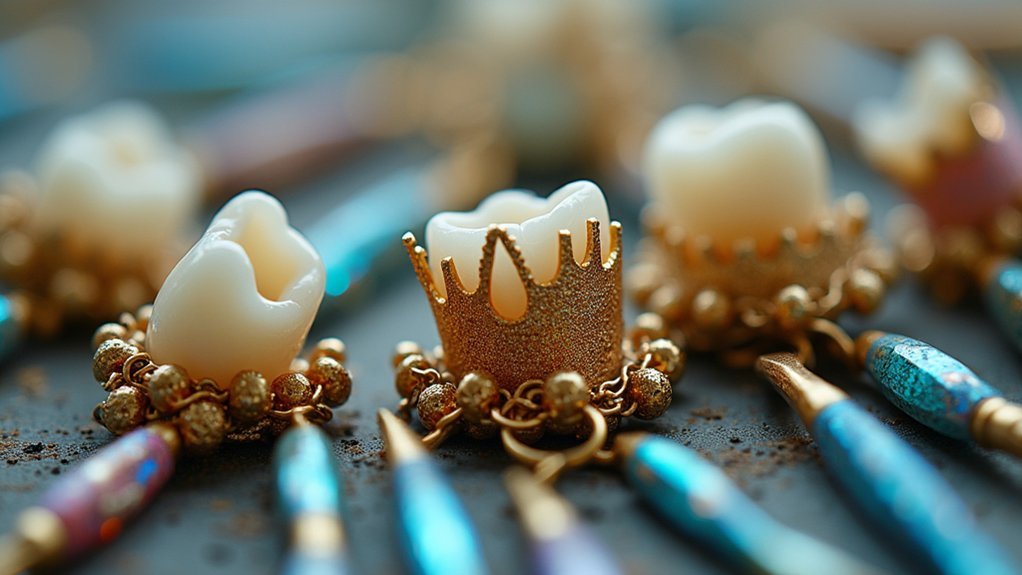
Although most people don’t realize it, the dental industry creates a treasure trove of recyclable precious metals that can transform into beautiful jewelry.
When dentists remove crowns and fillings, they’re discarding gold, silver, and platinum that represents one man’s trash becoming another’s treasure.
Companies like Betts Metals specialize in sourcing these precious metals from dental discards, processing them into high-quality materials for sustainable jewelry production.
This innovative approach offers several benefits:
- Reduces landfill waste by repurposing valuable materials
- Minimizes environmental impact by eliminating virgin mining needs
- Creates unique jewelry pieces with interesting backstories
Plastic Container Transformation: Creating Jewelry From Takeout Waste
You’ll need to master specific cleaning protocols before transforming plastic takeout containers into stunning jewelry pieces.
Start by removing all food residue and adhesive labels, then sanitize each container using degreasing agents that won’t compromise the plastic’s integrity.
Once you’ve prepared your materials, you can explore various cutting, shaping, and assembly techniques that’ll turn everyday waste into wearable art.
Cleaning and Preparation Techniques
Before diving into the creative aspects of transforming takeout containers into stunning jewelry pieces, you’ll need to establish a solid foundation through proper cleaning and preparation. These essential cleaning and preparation techniques guarantee your materials are ready for crafting and will produce professional-looking results.
Start by thoroughly washing your plastic containers with warm, soapy water to eliminate all food residue and grease. Any contamination left behind can interfere with paint adhesion and overall appearance.
- Remove stubborn stickers and labels using adhesive remover or heat from a hair dryer.
- Sand rough edges smooth with fine-grit sandpaper for comfortable wear.
- Wipe surfaces with rubbing alcohol to remove fingerprints and guarantee ideal paint bonding.
Once cleaned, you’re ready to begin cutting and shaping your containers into beautiful jewelry components.
Design and Assembly Methods
With your cleaned containers ready, you can now focus on transforming these everyday items into wearable art through strategic design choices and assembly techniques. Remember, one person’s trash is another man’s treasure when you’re creating unique jewelry pieces.
Start by cutting your plastic containers into desired shapes using sharp scissors or craft knives. Sand rough edges smooth, then drill small holes for jump rings or wire connections. You’ll embellish surfaces through painting, adding beads, or creating texture patterns.
| Technique | Tools Needed | Design Effect |
|---|---|---|
| Cutting | Scissors, craft knife | Geometric shapes |
| Drilling | Small drill bits | Connection points |
| Sanding | Fine sandpaper | Smooth edges |
| Painting | Acrylic paints | Color enhancement |
| Wire wrapping | Jewelry wire | Secure assembly |
Assembly involves connecting components using jewelry findings, creating stunning conversation-starting accessories.
Tin Can Artistry: Crafting Elegant Pieces From Food Packaging
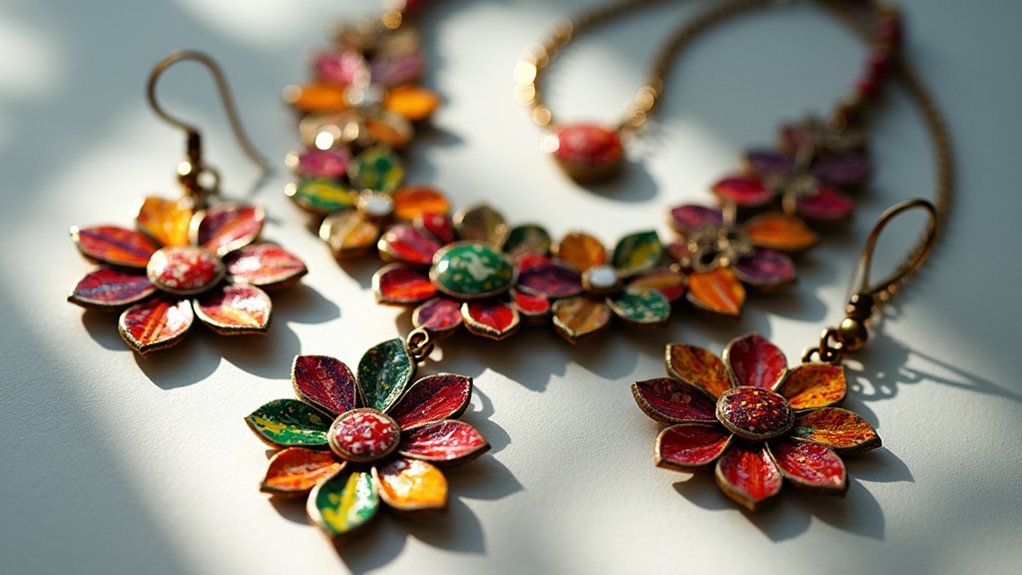
Transform yesterday’s soup cans into stunning statement pieces that’ll turn heads and spark conversations about sustainable fashion.
You’ll discover that one man’s trash is another person’s treasure when you explore tin can artistry. This eco-friendly craft transforms discarded food packaging into elegant jewelry that rivals expensive boutique pieces.
Start your creative journey by cleaning and flattening empty cans, then cutting them into your desired shapes.
You can enhance each piece through:
- Painting vibrant colors or metallic finishes for visual impact
- Embossing intricate patterns using simple household tools
- Adding decorative elements like beads, stones, or fabric accents
Your finished tin can jewelry becomes more than just accessories—they’re conversation starters that promote environmental awareness while showcasing your commitment to sustainable fashion practices.
You’re reducing waste while creating beautiful, unique pieces.
Digital Memory Jewelry: Converting Location Data Into Physical Forms
While physical materials like tin cans offer tangible starting points for sustainable jewelry, your digital footprint holds equally powerful potential for creating meaningful accessories.
Digital memory jewelry transforms your location data from social networks into personalized wearable art that captures significant memories and experiences.
Through platforms like Meshu, you can retrieve location information from Foursquare and other sources to memorialize places that hold personal significance.
This innovative approach converts intangible digital interactions into physical jewelry pieces, creating unique designs that tell your individual story.
You’re fundamentally turning data trash into treasure, transforming forgotten check-ins and location tags into sustainable, meaningful accessories.
This intersection of technology and personal storytelling represents eco-conscious fashion that celebrates your digital history through thoughtful, personalized designs.
Industrial Waste Utilization: Mining Landfills for Hidden Treasures
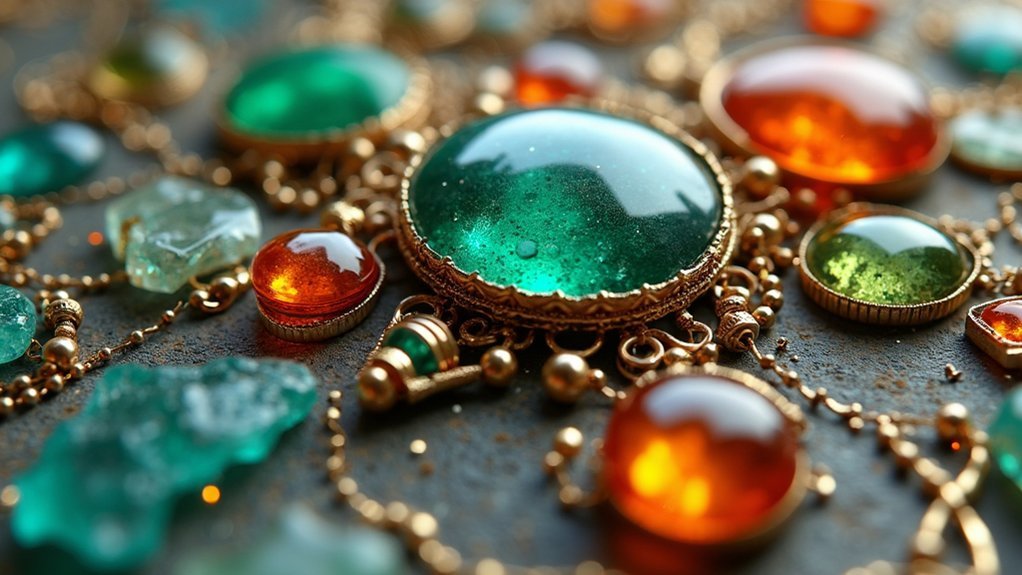
Sixteen percent of electronic waste gets recycled globally, leaving millions of tons of discarded devices sitting in landfills despite containing more gold per ton than traditional mining ore.
Millions of tons of gold-rich electronic devices waste away in landfills while jewelers overlook this untapped treasure trove.
You’re overlooking a goldmine of jewelry materials when you ignore industrial waste streams.
Forward-thinking jewelers are already tapping into these unconventional sources:
- E-waste extraction – One ton yields 300 grams of gold versus just 30 grams from traditional ore
- Medical waste recovery – X-ray films contain recoverable silver, as demonstrated by The Royal Mint’s innovative programs
- Corporate partnerships – Companies like Brilliant Earth source 93% recycled gold from industrial waste streams
With 64.5 million tons of e-waste generated annually, you’ve got access to an enormous supply chain that transforms discarded electronics into stunning, sustainable jewelry pieces.
Thrift Store Revival: Breathing New Life Into Broken Jewelry
Beyond industrial waste streams, thrift stores offer another treasure trove of raw materials hiding in plain sight.
You’ll find countless pieces of broken jewelry waiting for transformation into unique accessories. Those tangled necklaces and damaged bracelets aren’t trash—they’re your creative canvas.
When you repurpose these discarded items, you’re crafting one-of-a-kind pieces that tell compelling stories. Each transformed piece becomes a conversation starter while supporting sustainable fashion practices.
You’re also tapping into the growing demand for eco-friendly products. This cost-effective approach lets you create personalized gifts or sellable handmade goods.
You’ll discover that transforming thrifted broken jewelry builds community awareness about sustainability. Your creativity becomes a powerful tool for combating waste while expressing your unique artistic vision.
Social Media Integration: Using #RestoreYourShore for Ocean Conservation
Since social media campaigns can amplify conservation efforts exponentially, the #RestoreYourShore initiative transforms your beach cleanup activities into powerful fundraising tools. When you share your ocean conservation efforts using this hashtag, each post generates a $5 donation to the Better Beach Alliance through the Surfrider Foundation.
Your participation becomes especially significant during “The Morning After” – the surge of single-use plastic waste following Independence Day celebrations.
Here’s how you can maximize your impact:
- Share photos of your beach cleanup efforts before July 5th at 11:59pm PST
- Include the #RestoreYourShore hashtag in all conservation-related posts
- Document your jewelry-making process using collected beach debris
This campaign excels at raising awareness about plastic pollution while fostering year-round engagement in coastal protection efforts.
Community Workshop Techniques: Teaching Upcycling for Sustainable Design
While online campaigns like #RestoreYourShore spread awareness globally, hands-on community workshops create lasting local impact by teaching participants practical upcycling skills.
You’ll learn essential techniques like cleaning, painting, and decoupage to transform worn jewelry boxes into stunning storage solutions. These workshops show you how incorporating embellishments like beads and ribbons can elevate basic materials into personalized accessories.
Transform forgotten jewelry boxes into beautiful storage using simple techniques like painting, decoupage, and creative embellishments for personalized accessories.
You’ll discover the versatility of everyday discarded items, such as converting broken drawer faces into functional jewelry hangers.
Workshop facilitators encourage you to share your trash to treasure transformations on social media using hashtags like #trashtotreasure, inspiring others to embrace sustainable practices.
Brand Success Stories: Companies Leading the Recycled Jewelry Movement
Pioneers in the jewelry industry are proving that sustainable practices don’t compromise luxury or style.
You’ll find inspiring examples of companies transforming waste into beautiful recycled jewelry through innovative sourcing methods.
Leading brands are setting remarkable standards:
- Brilliant Earth uses 93% recycled gold and 99.8% recycled silver, demonstrating large-scale sustainable sourcing.
- 886 by the Royal Mint creatively extracts silver from discarded medical X-ray films, showcasing unique recycling innovation.
- Pandora commits to 100% recycled precious metals by 2025, responding to growing consumer demand for eco-friendly options.
You’re witnessing brands like Emblème transform electronic waste gold into fashionable pieces, while companies such as Lylie focus on improving recycling statistics.
These success stories prove that recycled jewelry isn’t just environmentally responsible—it’s luxurious, innovative, and commercially viable.
Frequently Asked Questions
What Basic Tools Do I Need to Start Making Jewelry From Trash?
You’ll need basic pliers, wire cutters, a small hammer, sandpaper, and a drill with various bits. Add super glue, jump rings, and findings like earring hooks. These tools’ll help you transform discarded materials into beautiful accessories.
How Do I Clean and Sanitize Found Materials Before Using Them?
You’ll want to wash materials with warm soapy water first. Use rubbing alcohol or diluted bleach for sanitizing. Let everything air dry completely. Sand rough surfaces smooth and remove any rust or corrosion before crafting.
What Safety Precautions Should I Take When Handling Unknown Waste Materials?
Always wear protective gloves, masks, and eyewear when handling unknown waste. Don’t touch materials with bare skin. Work in well-ventilated areas. Avoid sharp objects and potential toxins. Research materials first if possible.
How Can I Tell if Materials Contain Harmful Chemicals or Substances?
You can’t easily identify harmful chemicals in waste materials without proper testing equipment. Look for warning labels, avoid items with strong odors, and research common toxic materials before handling anything suspicious.
What’s the Best Way to Store Collected Materials Before Crafting?
You’ll want to clean your collected materials first, then sort them by type in labeled containers. Store everything in a dry, well-ventilated area away from direct sunlight to prevent deterioration.
In Summary
You’ve discovered how transforming discarded materials into beautiful jewelry creates meaningful change. Whether you’re mining e-waste for precious metals, collecting beach debris, or reviving thrift store finds, you’re making a difference. Start your own upcycling journey today—join community workshops, share your creations with #RestoreYourShore, and inspire others. You’ll not only craft stunning pieces but also protect our planet while building a more sustainable future through conscious creativity.

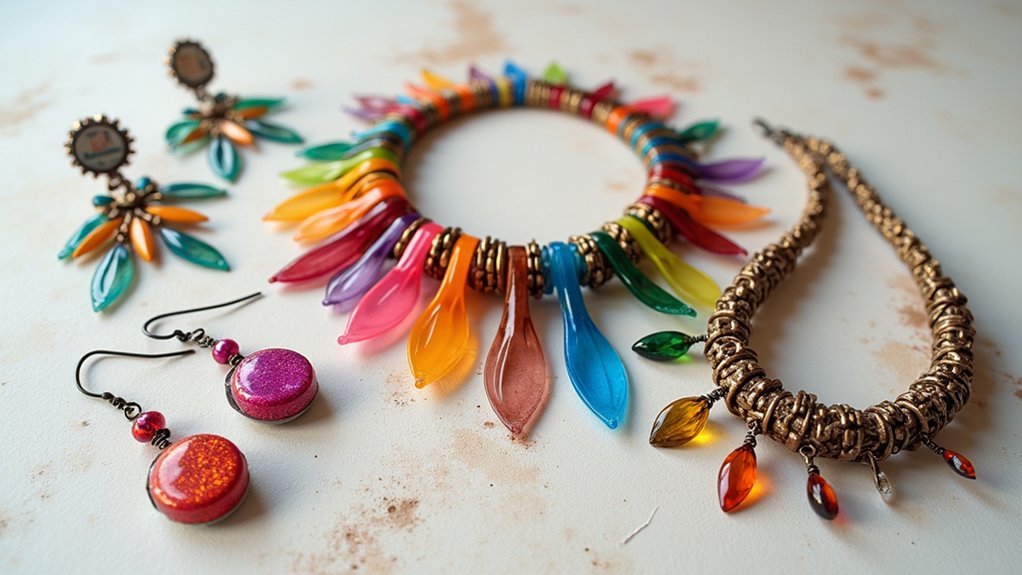



Leave a Reply